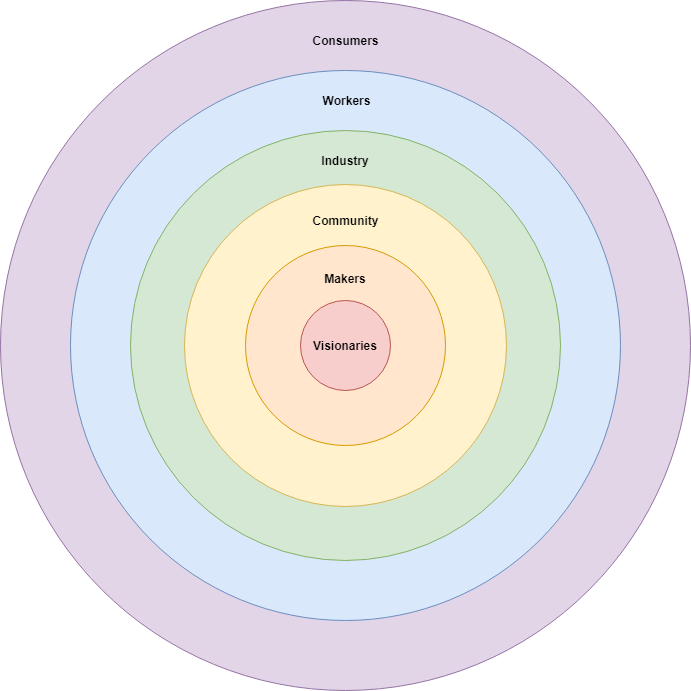
The Lifecycle of Technology
How is technology born? What makes some technologies so popular while other don’t make it past the drawing board? Why do some technologies get all the way to the top, then die far too soon, when others live on for decades?
In this article, I’m going to discuss the life-cycle of technology, be it a cellphone, an electric car, or just a simple programming language or development pattern. All of these (and more) fall under the definition of technology.
There are several key players that contribute to the life and death of a certain technology. Technology is created, made popular, consumed and destroyed by people – from the smartest technologists to the average consumers.
The Visionaries
Every technology out there starts with an idea that’s driven by a passion to right a wrong, or change the world as we know it into something better. The best technologies out there are the ones born out of the mind of a visionary who is trying to make the world better by starting with his or her own life, wanting it to be something more than ordinary.
Visionaries are not necessarily engineers or technologists, but they are futurists who try to imagine and envision a better, faster, more efficient future, but then they have the courage to take that to the next level and turn an idea into a reality.
Visionaries don’t necessarily come up with an idea that was never thought of before, they might take an existing idea and do it differently, or do it even better!
There are many visionaries in our modern age and we could certainly learn from their stories. People such as Steve Jobs, Jeff Bezos, Elon Musk or Bill Gates definitely come to mind.
It’s true that each one of them might have had a different story of how they found their original idea and took it to the world and changed it forever, but what we should seek here are commonalities among these people, starting from where they stopped and become visionaries ourselves.
One of the most fascinating commonalities among all the visionaries in the past and in our modern age is their courage to take risks and try different things, especially when trying to make something our society doesn’t yet understand. The benefits of a new idea may not be immediately recognizable in technology just as they were not quite understood in the new technologies of the past.
The Makers
Visionaries turn ideas into realities by either cooperating with makers, or they become the makers themselves.
When Elon Musk envisioned PayPal, an online system for processing, receiving and sending funds anywhere in the world, he was also the maker of his own vision.
But in the Apple, Inc scenario, Steve Jobs had to cooperate with Wozniak to turn his vision into a reality, without Wozniak it would have been a lot harder for Jobs to bring Apple computers into what they are today.
Makers are not just people who have a skill, they are a lot more than that. they are people that look at the current technology in hand and think about how create something better out of it.
Makers are hackers, they don’t settle for the status quo, they are exceedingly good at what they do that they can turn a vision into a reality even if the current technology says it can’t be implemented.
And while it’s inspiring to learn courage and risk-taking from the visionaries, the makers inspire us to get better at what we do, not just to get the job done, but to make the impossible, possible. They inspire us to go beyond the textbook, beyond what the manual says – to hack their tools and never stop believing that they (and we) can get more out of it.
Some of the most famous makers out there are people like Wozniak, James Gosling, Dennis Richie, Larry Page and Sergey Brin.
One of the most common things among these makers is their devotion and staying true to their values and skills. They reached the top at what they did and turned it into something that changed the world forever.

The Community
The early-adapters, people who are not scared to try the beta or the alpha version of some technology and not just stop there, but to communicate with the makers and the visionaries to help bring their product to reality, into something that could hit mass markets and main stream.
Community could be authors who try the technology and document it, create tutorials, videos or write books about it.
It could also be the contributors in open-source projects. These are the semi-makers who pull technology into their lives by keeping it alive, pushing new features and fixing issues. These are those who are touched by the vision, inspired by the products and are willing to push it further with whatever skill-sets they may have.
Technology advocates also fall under the umbrella of community, except that advocates are a lot more organized and systematic than the average open-source community contributor.
One of the most vibrant communities out there are the Linux communities, with all of their distributions, apps, and kernel developments.
There was a time in history when Linux was frowned upon by corporations which created proprietary alternatives at the time. If it wasn’t for the community surrounding Linux, it wouldn’t have become what it is today and community keeps pushing Linux, further, morphing it into more cloud-based technologies such as docker containers and web servers which forced even the proprietary software companies to recognize their existence and cooperate even more with the communities to find some business value in their product.
A visionary and a maker who don’t know how to create a community around their products can’t go very far. The social aspect of technology is of utmost importance and without it, the vision can just be gone, forgotten, or discarded.
Devotion is the most inspiring aspect of communities, the social nature of getting to work with others who share the same passion and communicate with them on that special social sphere.
Communities carry the vision of the visionaries, and develop the skill-sets of the makers, and in some cases, communities will give birth to new makers and visionaries and keep the idea going long after the visionary and the maker are gone or moved on to other ideas.
The Industry
Corporate, startups and even free-lancers are entities that are influenced by the popular, most modern technologies promoted by the communities.
For instance, a few years ago JavaScript was nothing but a simple scripting language that web developers used for some validations on their websites.
But then the community adopted the language and started pushing it to the server-side, built hundreds of thousands of libraries to support every aspect of web development needs, which eventually caught up to the software industry.
Corporations had no option but to rewrite a lot of their technology stack in JavaScript, simply because that was the easiest way to find skill sets in the software market today. It’s also the easiest way to find solutions for its most common issues on community powered forums such as StackOverFlow and GitHub.
The adaptation of the industry gives any technology at least two decades of a lifetime before the next new technology takes over.
Workers
Industries produce their own community of technology maintainers and users, but they are not usually as passionate as the community that made the technology popular in the first place.
When a company adopts a certain technology, new employees will need to learn that technology and use it whether they are passionate about it or not.
And this is when a technology faces it’s most important challenge, being used by people who don’t really care much for it, and so easy to give up on it if it doesn’t get the job done.
Most of corporate workers won’t try to go to an open-source project to try to fix a problem with which they are dealing in regards to a certain technology. They would rather just complain and go find an alternative.
Complaining about some drawbacks in a certain technology is a lot better than saying nothing because when a worker who has to use the technology leaves a comment on a community website or a forum, the early-adapters and passionate members of the community have the opportunity to address that and make sure the next release addresses the issues. They can address the issues the workers find in the technology and offer a fix as fast as they can.
This back and forth between non-passionate technology users and the community can either contribute to the empowerment of the technology, making it better, fast and reliable.
Or it can backfire. When the amount of complaints not being addressed exceeds the amount of the contributors in the community to address them, the “hacks” begin to bend the technology backwards, misinformation starts to spread on social media and the technology starts getting “sick” and eventually dies.
Technologies can only live as long as there are maintainers and contributors that are willing to put in the hours and keep the technology relevant to the day and age it’s in.
That’s why some corporations will adopt the maintainers of the technology and foster communities of passionate contributors to keep the technology alive. But even when someone has a day job to maintain a technology, it’s still not as powerful unless they have an inner passion to keep it alive. Technologies may stay on life-support for just as long as a corporation is willing to spend the money to keep it alive, but once it pulls the plug and cuts the funding, the technology ceases to exist.
Consumers
The last portion here are the consumers. In the software development world, consumers don’t really know the specific technology that was used to create a website or mobile app, but they will definitely not support a product that simply doesn’t work or requires a lot of time and effort to get something done.
Engineers will question the design and vision of the product just long enough before realizing that the technology itself is the problem and that they need to move on.
End-users are the backbone that keeps corporations and their workers interested in creating products in certain technologies. There have been scenarios in which consumers of products, like Apple’s Newton, quickly decided the product didn’t live up to the expectations and Apple ended up shutting the project down before it became an historical prodigy like so many of Apple’s products.
Knowing the life-cycle of technology helps us predict where it’s headed and whether it’s worth the investment of time and effort or not.
Understanding how technology is born, grown and how it dies helps technologists adjust their visions, and change their direction to stay relevant, useful and innovative and to continue to provide value to the world.
